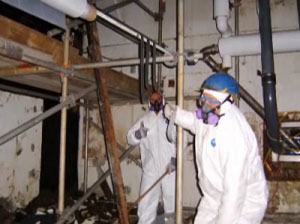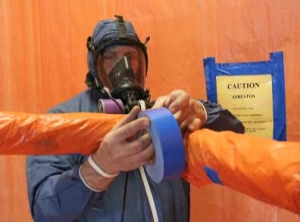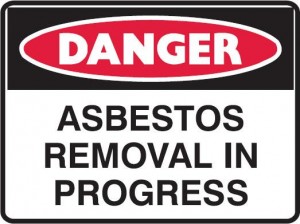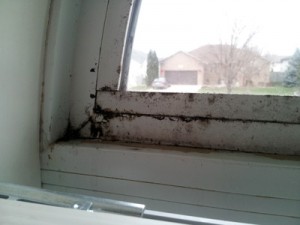We hope you, as a business or homeowner, find our information helpful. If you have a question, use the contact link to email R.C. White.

Can you remove asbestos? The R.C. White Ltd. team are trained professionals that can help you abate asbestos and other toxic construction materials used in older homes and commercial properties. Asbestos may have been banned in the 1970s, but that doesn’t mean it has disappeared. It’s still in many homes and commercial properties built between 1930 and 1950. It was a common material used to insulate properties and as fire retardants. Asbestos is mostly commonly found in siding or roofing tiles, in wraps around coal or oil furnace pipes and in flooring. Take every precaution when inspecting asbestos and have removal done by a trained professional. Don’t saw, sand, scrape or drill holes in materials that contain asbestos. Don’t dust or vacuum debris that may contain asbestos. Don’t try this at home! When asbestos flooring needs to be replaced, install flooring overtop of it, but don’t remove it yourself. Hire an asbestos abatement professional before considering removing any contaminated material. Asbestos…
How dangerous is asbestos? Many construction companies don’t take the proper precautions or follow regulations when disposing of toxic building materials, reported the Environmental Advisory Committees of Ontario in its newsletter. Part of the problem is that property owners aren’t investigating whether they have toxic materials like asbestos onsite before finding a contractor to do renovations, said the Environment Abatement Council of Ontario. There are regulations mandating the proper handling and removal of dangerous materials like asbestos, mould and PCBs. Property owners should compile a list of possible hazardous materials that may be found during construction before going out to bid. Once a list is established, then property owners can be sure to hire contractors with the proper qualifications, like R.C. White Ltd., to abate the materials. An assessment for asbestos can be done by visually surveying the material, doing sample testing to find if asbestos is in the dust or air and interpreting the results.…

Renovations and Asbestos If you own an older home or commercial property and are considering renovating the site, pause before searching for a contractor. Often when construction projects begin it’s not known how much toxic materials were used in original construction or where it’s located on site. Before embarking on a construction project, the property owner and contractor should mark potential locations of possible asbestos contamination. If a demolition begins and suspected asbestos fibers are found, all work should stop immediately. Only trained contractors who specialize in asbestos removal should be entrusted with eliminating the substance. They wear protective gear and dispose of the substance properly. Windsor’s R.C. White Ltd. is one of those firms. The company has years of experience and can easily make your home or business safer. If a construction firm continues its work without taking the proper precautions, it is putting the lives of its workers at risk. The Ontario Ministry of Labour recently…

Does my older home have asbestos? Aging properties can be charming and cheaper than new, but there are dangerous materials used in construction decades ago that have since been banned. If you are considering renovating or doing repairs to an older home or commercial building, investigate whether your property is toxic substance free by contacting R.C. White Ltd. for a consultation. The only proper way to deal with noxious substances is to hire trained professionals who know how to extract and dispose of the substances. There are 11 materials that were commonly used in construction from 1930 to 1950 that are dangerous to a person’s health and no longer used. So long as the substances are undisturbed, there is no need to worry. Occasionally renovations or repairs are required and demand the removal of substances like asbestos, lead, mercury and arsenic. In particular asbestos, which was banned in 1977, can be found in roofing and siding shingles and was used as insulation. It might also have been combined with textured…

Getting drier air in winter Getting interior air drier and fix leaks that contribute to moisture is the best long-term solution to the problem of mould. Removing mould is R.C. White’s specialty. We are southwestern Ontario’s specialists in the safe and complete removal of mould in homes and businesses. Getting drier air and removing mould: You can find mould almost anywhere in your home and you can remove some of it yourself. If you have a large mould infestation don’t risk removing it and harming your health. Having a lot of mould in your home can cause an allergic reaction with sneezing, runny nose, headaches and eye irritation. Mould can gather in the grout lines of your shower or discolour drywall. If you find small spots of mould use a diluted bleach solution to scrub the area and let it dry. Wear rubber gloves and avoid contact with the skin because bleach can cause irritation. Once you are done open a window or run a ventilation fan when doing cleanup work to remove fumes. If you have a musty odour in…

How do I remove moisture in air? During the winter the humidity level in a home has to be balanced. When the air is too dry, people complain of dryness, static electricity and wood floors and furniture start to separate and crack. When it’s too humid indoors, moisture condenses on cold surfaces like condensation on windows. The perfect compromise is to have humidity levels between 30 and 40 percent during the winter. The simplest solution to having moist air is improving air circulation to cool surfaces. Here are a few recommendations to remove moisture: • Pull back drapes to warm up the windows, open closet doors, move furniture away from exterior walls and increase the temperature to problem areas. • The next step is to reduce the humidity level in your home and find where you have excess water. Check for leaks and water damage under sinks, around tubs and showers. Look for damp areas or water stains. Cooking and showers can add moisture to the air. • Make sure your dryer vents to the outside and keep showers…
